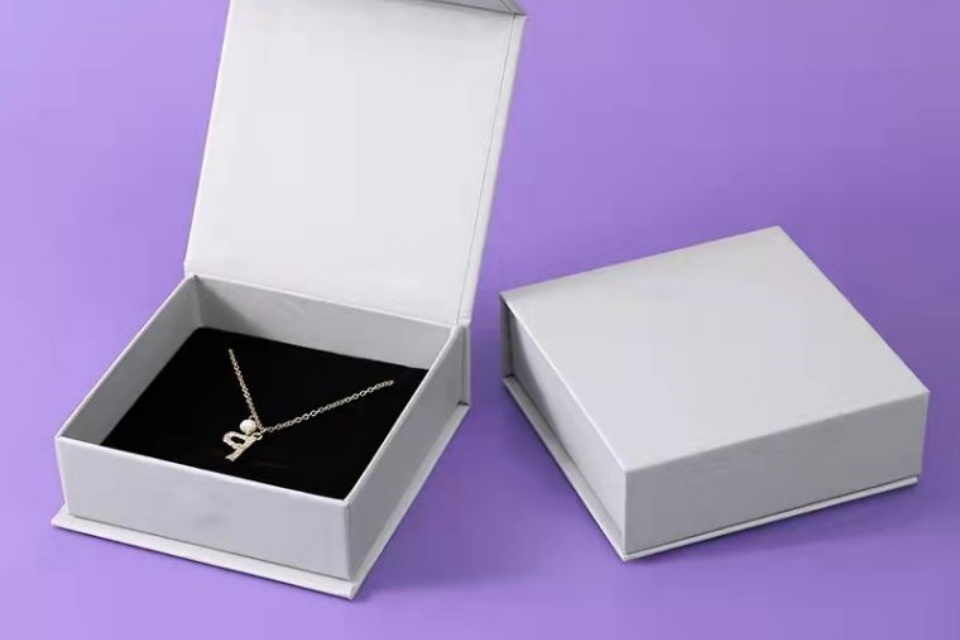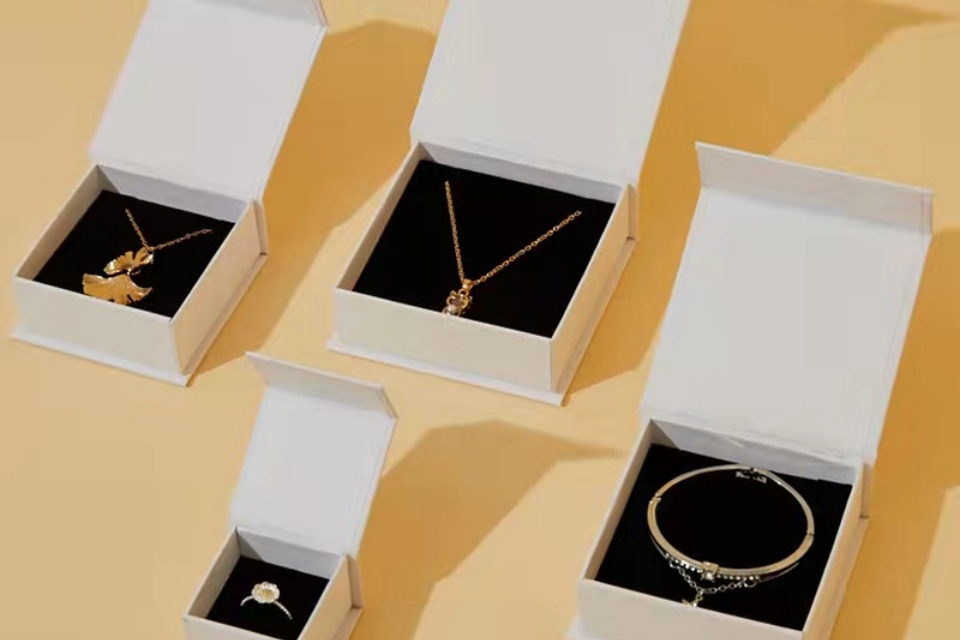Magnetic Closure vs. Standard Lid-and-Base Rigid Boxes
This article compares magnetic closure and standard lid-and-base rigid boxes, detailing their designs, functionality, and use cases for premium product packaging.
Summary
Magnetic closure boxes and standard lid-and-base rigid boxes represent two distinct types of packaging solutions widely utilized across various industries. Magnetic closure boxes utilize embedded magnets to create a secure and elegant closure, making them particularly appealing for luxury products and high-end branding. In contrast, standard lid-and-base boxes consist of a separate lid and base, offering versatility and durability suitable for a range of applications, from electronics to jewelry. Both packaging types enhance the consumer experience through their aesthetic appeal and protective capabilities, which can significantly influence purchasing decisions.
The notable distinction between these two designs lies in their functionality and market perception. Magnetic closure boxes are praised for their luxurious presentation and ease of access, enhancing user interaction through a seamless unboxing experience. They are often associated with higher perceived value, but this comes at a cost, as they tend to be more expensive to produce compared to standard lid-and-base options. On the other hand, standard rigid boxes are celebrated for their simplicity and cost-effectiveness, making them a popular choice for a broader range of products, although they may lack the same high-end feel.
The ongoing growth in the rigid packaging market is largely driven by evolving consumer preferences and the rise of e-commerce, with an expected market value exceeding $5.4 billion by 2030 for rigid boxes alone. Brands are increasingly adopting packaging that aligns with eco-conscious trends, further enhancing their market appeal and customer loyalty. The choice between magnetic closure and standard lid-and-base boxes often involves a trade-off between luxury and practicality, a decision that can impact brand perception and consumer satisfaction.
In summary, both magnetic closure boxes and standard lid-and-base rigid boxes play crucial roles in product packaging, catering to different market needs and consumer expectations. The selection of packaging type can significantly influence branding strategies and customer engagement, making it a critical consideration for businesses aiming to differentiate themselves in a competitive landscape.
Table of Contents
Definitions
Magnetic Closure Boxes
Magnetic closure boxes are a type of packaging that utilizes embedded magnets within the lid and front panel to create a secure and seamless closure. These boxes are primarily made from high-quality paperboard or rigid cardboard, offering both functionality and an elegant aesthetic. They are designed to provide a luxurious unboxing experience, making them particularly suitable for luxury products and high-end branding. Key features of magnetic closure boxes include their secure closure mechanism, premium look and feel, durable construction, and the ability to be customized through printing, embossing, or lamination.
Rigid Lid-and-Base Boxes
Rigid lid-and-base boxes consist of two main components: a lid and a base. These boxes can be designed in various shapes and sizes, including triangles, rectangles, and circles. They are characterized by their sturdy construction, which provides superior protection for high-value items such as electronics, jewelry, or luxury cosmetics. The design typically includes a separate lid that partially covers the base, enhancing the box’s structural integrity and aesthetic appeal. Customization options for these boxes are extensive, allowing for various types of lids, such as hinged, classic, or window-cut designs, to suit specific product needs and preferences. Rigid boxes are especially valued for their ability to create a memorable unboxing experience, which can significantly influence consumer perceptions and purchasing decisions.

Design Characteristics
Standard Lid-and-Base Rigid Boxes
Standard lid-and-base rigid boxes, on the other hand, consist of two separate components: a lid that fits over a base. This traditional design is versatile and widely used across many industries.
Simplicity: The straightforward construction makes them easy to manufacture and assemble, which can lead to cost-effective production methods.
Versatility: Standard lid-and-base boxes can accommodate a variety of products and are suitable for both consumer goods and premium items, though they may not provide the same high-end feel as magnetic closure boxes.
Finishing Options: These boxes can also feature various finishes, such as partial or full wraps, and can include decorative elements to enhance aesthetic appeal.
Overview of Rigid Boxes
Rigid boxes are renowned for their sturdy construction, typically made from thick paperboard and high-quality wrapping materials. They are designed not only to protect the contents but also to enhance the overall consumer experience through luxurious presentation and functional design. The design process of a rigid box involves multiple stages, including initial consultation, material selection, prototype development, and final customization.
Magnetic Closure Boxes
Magnetic closure boxes are a specific type of rigid box that feature embedded magnets within the lid and front panel, allowing for a secure and seamless closure. This design not only ensures that the box remains tightly closed, protecting its contents, but also adds an element of sophistication, making them particularly suitable for luxury products and high-end branding.
Secure Closure: The embedded magnets provide a reliable and secure closure, enhancing the user experience by preventing accidental openings.
Premium Look and Feel: These boxes offer a luxurious appearance, ideal for brands looking to convey quality and exclusivity.
Durable Construction: Made from robust materials, magnetic closure boxes are built to withstand handling and transport, ensuring the safety of the items inside.
Customizable Options: The surface of magnetic closure boxes can be tailored through various methods such as printing, embossing, or laminating, allowing brands to create a distinctive identity.
Visual Hierarchy and Branding
Regardless of the type, the design of rigid boxes plays a crucial role in brand perception. Effective packaging design incorporates a clear visual hierarchy, allowing consumers to easily identify product names and brand identities. Strong visual elements such as bold text and vibrant logos can enhance brand recognition and contribute to overall customer satisfaction.

Functionality
Magnetic closure boxes and standard lid-and-base rigid boxes each offer distinct functionalities tailored to different packaging needs.
Product Protection
Both types of boxes excel in providing protection for their contents. Magnetic closure boxes feature embedded magnets in the lid and front panel, ensuring a secure closure that keeps the box tightly sealed during transport and handling. This design is particularly beneficial for high-end products, as it minimizes the risk of damage and enhances the unboxing experience. In contrast, standard rigid boxes are typically constructed from sturdy materials and can be customized for thickness, allowing for adequate protection that fits the product perfectly. This customizability ensures that items are well-secured, reducing movement that could lead to damage.
Ease of Use
Magnetic closure boxes offer ease of access thanks to their intuitive design. The seamless magnetic closure allows for quick opening and closing, making it user-friendly for consumers who value convenience. Additionally, features such as built-in handles or finger holes can be incorporated into standard rigid boxes to enhance their usability. While both types aim to provide functional solutions, magnetic closure boxes tend to provide a more luxurious and sophisticated interaction upon unboxing.
Versatility and Customization
The versatility of magnetic closure boxes allows for a variety of applications across different industries, ranging from cosmetics to electronics. Their customizable design can include printing, embossing, or laminating for a premium finish, making them suitable for luxury branding. On the other hand, standard lid-and-base boxes can be adapted with additional features such as inserts or compartments to organize products effectively. This adaptability caters to a broader range of products, ensuring that packaging meets specific functional requirements.
Innovative Features
Both box types can incorporate innovative elements to improve product functionality. Magnetic closure boxes can integrate features like interactive elements such as QR codes, offering instant access to product information. Meanwhile, standard rigid boxes can include design elements such as compartments and dividers that enhance organization and protect accessories. These innovations not only elevate the functionality of the packaging but also enrich the consumer experience.

Applications
Magnetic closure boxes and standard lid-and-base rigid boxes serve a variety of applications across multiple industries, catering to different packaging needs and consumer preferences.
Magnetic Closure Boxes
Magnetic closure boxes are favored for their elegant design and secure functionality.
Standard Lid-and-Base Rigid Boxes
Standard lid-and-base rigid boxes, known for their classic design, are predominantly used for a variety of applications:

Advantages and Disadvantages
Magnetic closure boxes offer a variety of advantages that set them apart from standard lid-and-base rigid boxes.
Advantages
Security and Reusability
One of the foremost advantages of magnetic closure boxes is their innate security. The embedded magnets hold the box firmly closed, preventing accidental openings and ensuring that the contents are safe during transportation. This feature provides peace of mind to both retailers and customers, who can be confident that their products arrive in perfect condition. Furthermore, the reusable nature of these boxes makes them an eco-friendly choice, aligning with the growing trend towards sustainability in packaging solutions.
User Experience
Magnetic boxes are designed for ease of use, allowing for a seamless opening and closing experience. This functionality enhances user satisfaction, particularly for products that require frequent access, such as cosmetics or electronics. The tactile engagement of the magnetic snap also encourages consumers to interact with the packaging repeatedly, enhancing their overall experience and promoting brand loyalty.
Durability and Versatility
Magnetic closure boxes are durable and provide superior protection against damage during transit, making them suitable for high-end products like jewelry and luxury cosmetics. Additionally, their customizable nature allows businesses to tailor the boxes to fit a wide range of products securely, which is a significant advantage over standard rigid boxes that may not offer the same level of adaptability.
Enhanced Brand Image
These boxes also contribute to an enhanced brand image. Their sleek design and sophisticated appearance elevate the product’s perceived value, allowing brands to convey messages of luxury and quality effectively. This improved brand perception can lead to increased customer engagement and sales.
Disadvantages
Cost Considerations
Despite their many advantages, magnetic closure boxes can be more expensive to produce than standard lid-and-base rigid boxes. This higher cost may deter some businesses, particularly those operating on tighter budgets.
Complexity in Design
The complexity of the magnetic closure mechanism may also pose challenges in the design and manufacturing process. Ensuring that the magnets are correctly aligned and embedded requires precision, which can complicate production timelines and increase costs.
Consumer Expectations
While magnetic closure boxes can enhance perceived value, they may also set high consumer expectations regarding the product inside. If the product does not meet these expectations, it could lead to dissatisfaction, ultimately impacting brand reputation.

Market
The market for rigid packaging solutions, particularly those involving magnetic closure and standard lid-and-base designs, is experiencing significant growth driven by evolving consumer preferences and e-commerce expansion. The rise of work-from-home opportunities has led to increased online shopping for various products, notably luxury and gift items, with an expected market value exceeding $5.4 billion by 2030 for rigid boxes alone. Custom two-piece rigid setup boxes are anticipated to lead this market segment, with a projected value of $268 million by 2025.
Consumer Preferences and Trends
Recent surveys indicate that while environmental considerations rank lower in importance compared to price, quality, and brand reputation among U.S. consumers, there is a growing trend towards eco-conscious purchasing behaviors. Brands that adopt sustainable packaging solutions, such as rigid boxes, not only cater to these preferences but also enhance their market appeal. This has emerged as a unique selling point that positively impacts brand perception and customer loyalty.
Advantages of Domestic Production
With the backdrop of global market uncertainties and trade complications, many businesses are opting for American-made rigid boxes. Partnering with domestic suppliers can offer several advantages, including faster time to market and the elimination of supply chain uncertainties associated with overseas production. This shift enables brands to respond quickly to market demands and seasonal trends, thus maintaining a competitive edge.
Collaborative Opportunities
E-commerce also fosters exciting collaboration opportunities between brands. Custom packaging can serve as a platform for co-branding initiatives, allowing companies to reach broader audiences through innovative marketing campaigns and unique product offerings. Such collaborations can manifest in limited-edition packaging designs or co-branded product bundles, further enhancing market presence and customer engagement.
